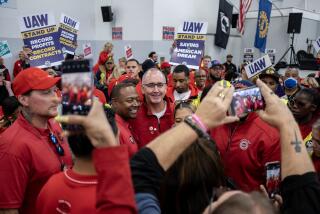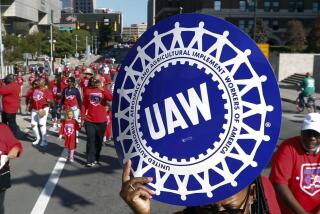Chrysler: The Allure of Outside Sources Grows
DETROIT — The strike is finished, Chrysler’s 70,000 union workers in the United States are back on the job with fatter paychecks and the No. 3 auto maker’s assembly lines are once again cranking out new cars and trucks.
But things have changed at Chrysler in the strike’s aftermath. In order to reap its share of Chrysler’s huge profits, the United Auto Workers union has abandoned its recessionary strategy of moderating its wage demands in return for job security, reverting instead to its traditional approach of striking over short-term economic goals such as higher wages.
In response, Chrysler is moving with increasing speed to offset its higher labor costs by shipping more work out to low-cost suppliers in the United States and around the world. The company, which essentially bought off the union’s demands for curbs on Chrysler’s use of imported parts by agreeing to higher wages, now remains free to strengthen its ties to its parts-supplying affiliates in Japan and South Korea.
As a result, Chrysler will be paying full freight for labor for the first time since 1979, when union workers first agreed to wage concessions to help keep Chrysler afloat. In the end, Chrysler will be paying those higher wages out to fewer and fewer workers.
Chrysler’s expensive new three-year settlement with the UAW provides its workers with wages and benefits that equal or surpass those paid by General Motors and Ford, eliminating the six-year labor cost advantage over its bigger domestic competitors that has been a key component in Chrysler’s remarkable turnaround. The final year of the new agreement even includes the largest pay hike granted workers at any domestic auto company since the industry’s boom times of the late 1970s, setting the pattern for future talks at GM and Ford.
But paradoxically, the union’s more aggressive approach to bargaining, Chrysler executives note, has come just months after the easing of import quotas on Japanese cars, increasing the pressure on Chrysler to move more production offshore.
In terms of its ability to compete internationally, the new contract, which will increase Chrysler’s labor costs by 6.5% a year and add more than $1 billion to Chrysler’s bill for labor over the next three years, just adds to that pressure, company officials and industry analysts say.
That’s especially true since the new contract won’t place any legal restrictions on the firm’s ability to “outsource”--or buy parts from outside suppliers, both foreign and domestic.
“I’m disappointed. It is too much of a short-sighted contract,” says Thomas W. Miner, Chrysler’s vice president for industrial relations and its chief bargainer. “It worries me that this is too much of a conventional labor settlement for this day and age.” He notes that company negotiators repeatedly warned the UAW during the talks that the union’s economic demands would lead to more foreign sourcing. “But the union didn’t want to hear about it,’ Miner complains.
But industry analysts don’t think the company is trying to bluff the union. “Chrysler tells me that as a result of the contract, they will redouble their efforts on outsourcing,” adds John Hammond, automotive analyst with Data Resources, a Lexington, Mass. economic forecasting firm.
Union Disagrees
Still, UAW leaders argue that Chrysler can easily afford the new contract, and that the new agreement provides Chrysler workers with the same job protection features first negotiated last year with GM and Ford.
“We didn’t go overboard. They can afford this,” says Marc Stepp, a UAW vice president and director of its Chrysler department. “We don’t want anybody to think we took advantage of the company.” Anyway, Stepp adds, the rank-and-file would not have accepted anything less from the union’s leadership than wage equality with GM and Ford, especially after Chrysler Chairman Lee A. Iacocca and Chrysler’s other top executives were granted huge bonuses last year.
“As soon as the company became profitable again, the top executives stuffed their pockets as full as they could,” Stepp says. “But when it came time to repay the workers for the sacrifices they made to keep this company afloat, management balked. That really angered the workers.”
Chrysler executives and industry analysts agree with the union that Chrysler, which last week reported record third-quarter earnings of $316.2 million and healthy nine-month earnings of $1.77 billion, can easily afford to pay its workers more.
Its worldwide car, truck and van sales in the first nine months of 1985 were up 10% from last year’s strong levels, and the company was sitting on a cushion of about $3 billion in savings and marketable securities at the end of the third quarter.
And, after selling off most of its non-automotive operations during its long financial crisis, Chrysler is also diversifying again by moving into profitable new fields through acquisition--corporate jet production (Gulfstream Aerospace) and financial services (E. F. Hutton Credit, FinanceAmerica)--in order to keep Chrysler healthy during automotive slumps.
Brags About Margins
Now, Iacocca even brags that Chrysler’s profit margins on its cars are higher than those of either GM or Ford, providing further ammunition to union leaders who argue that Chrysler shouldn’t be given a wage advantage over GM and Ford just because of its smaller size.
But one big reason that Chrysler has become so profitable is that the company has already subcontracted, or outsourced, so much of its production work to cheaper outside suppliers, thus softening the impact of its in-house labor costs. Chrysler now makes only about 30% of its own parts, while GM makes roughly 70% of its components with its own expensive work force.
The result is that Chrysler is paying UAW wage rates to proportionately fewer workers than either GM or Ford, and getting cheaper parts from outside suppliers in the bargain. In 1979, for instance, Chrysler built 1.2 million cars and trucks in the United States and had 109,306 American workers (salaried and union); in 1984 it had just 80,233 American employees but produced nearly 1.5 million cars and trucks in the United States.
Since 1979, Chrysler has also shuttered more than a dozen parts plants around the country while moving aggressively to automate and reduce employment at its remaining facilities. Chrysler says it will have about 700 robots installed in its plants by the end of the year, up from 570 at the beginning of the 1985 model year, and it expects to have 1,500 installed by the end of the decade.
Further Cuts Possible
Chrysler executives warn that they are now prepared to cut back on the firm’s in-house payroll even further, especially if the union refuses to help streamline union work rules--that management complains stifle productivity on the shop floor. Iacocca said last week that he was “disappointed” that Chrysler didn’t win stronger commitments from the UAW in such non-wage areas in return for the company’s meeting the union’s wage demands in the new contract.
Industry analysts say that Chrysler is already pursuing outside supply sources more aggressively than GM or Ford, and they predict that the auto maker will intensify those efforts now that its labor costs have increased.
For years, the company has been buying engines (along with fully built small cars) from Mitsubishi, its Japanese affiliate, and earlier this year established a new joint venture in South Korea with Korea’s Samsung Group, which will act as a supply base for Chrysler’s purchases of low-cost Korean parts. Last spring, Chrysler also set up a new international business development office to increase the firm’s foreign parts purchases and to look for more joint-venture possibilities overseas.
Chrysler Vice Chairman Gerald Greenwald insisted in an interview last week that the company has no immediate plans to expand its outside sourcing efforts in the wake of the contract, since an aggressive plan was already put in place following the Reagan Administration’s decision last spring not to clamp down on Japanese imports.
But other company executives say privately that the contract will do nothing but strengthen Chrysler’s resolve to buy more parts on the outside. And such outside purchases could soar as soon as car sales begin to plummet in the next recession, increasing the pressure on Chrysler to cut costs.
May Drop Operations
James Harbour, a former Chrysler executive and now a widely respected industry consultant, predicts that Chrysler may eventually rid itself of all of its component manufacturing operations except those that are too large or expensive for a supplier to handle.
“I think they are content simply to assemble their vehicles, make their transmissions, engines and some stampings, and buy the rest,” Harbour says. “The question is, why do they need to be a manufacturer of auto parts?” asks Hammond of Data Resources. “Why not just be assemblers of cars? That’s what they do best, anyway. Then they can shed their unprofitable parts operations.”
THE CHANGING PICTURE AT CHRYSLER Employment
‘79 109,306 ’80 76,711 ’81 68,696 ’82 58,607 ’83 65,832 ’84 80,233






